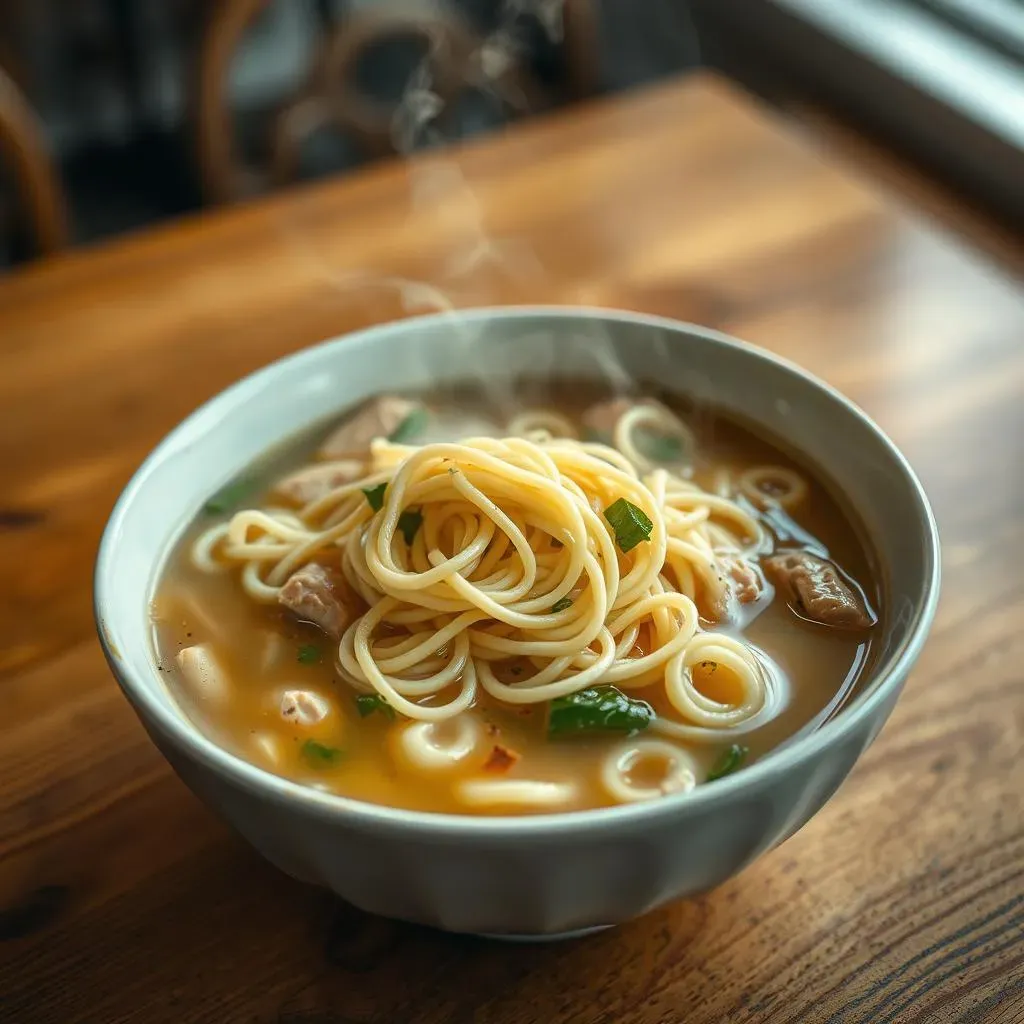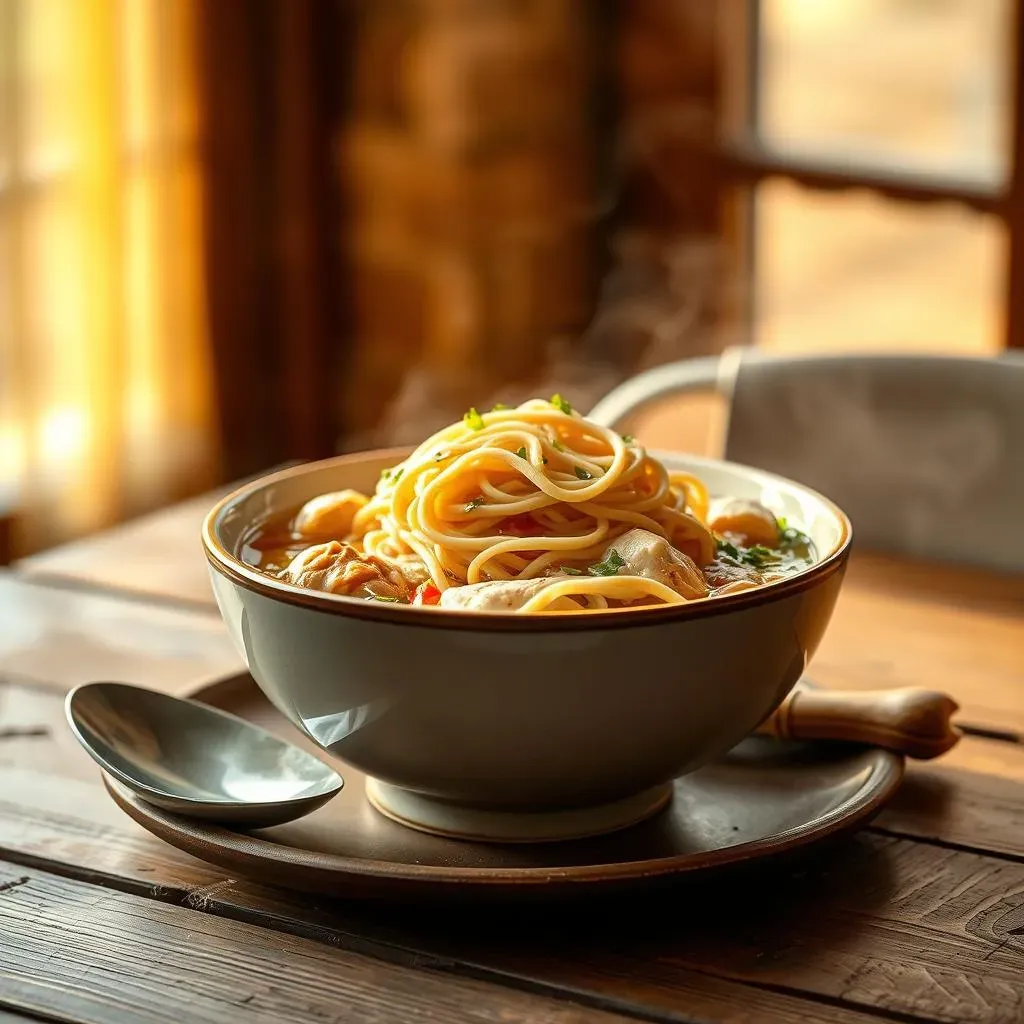Table of Contents
Is there anything more disappointing than a bowl of chicken noodle soup with mushy, overcooked noodles? I've been there, staring down at a sad, gloppy mess, wondering where I went wrong. The good news is, you're not alone, and more importantly, it's totally fixable. This article is your guide to achieving noodle nirvana in every bowl. We're not just talking about cooking noodles; we're talking about a strategic approach to “how to avoid soggy noodles in chicken noodle soup”. We will explore the core reasons why noodles turn to mush, show you the ideal way to prepare noodles for soup, and reveal the secret to keeping them separate until serving. Plus, I'll share my tips for reheating without turning your noodles into a soggy disaster. By the end, you'll be a noodle-soup master, ready to enjoy perfectly textured noodles every single time. So, let’s get to it and learn how to save those noodles!
The Problem with Soggy Noodles in Chicken Noodle Soup

The Problem with Soggy Noodles in Chicken Noodle Soup
The Noodle's Natural Enemy: Liquid
Okay, let's face it: soggy noodles are the enemy of a good chicken noodle soup. It’s like, you’ve made this beautiful, comforting soup, and then, bam, the noodles turn into a mushy mess. The main culprit here is simple: liquid. Noodles, especially the common ones used in soup, are basically sponges. They soak up any liquid they come into contact with, and the longer they sit in the broth, the more they absorb. This over-absorption is what leads to that dreaded soggy texture. It’s not a cooking failure necessarily, it's just the nature of the beast, or should I say, the nature of the noodle?
The Science of Swelling
It's not just about the soaking, though. There's some science happening, too. Noodles are made of starches, and when these starches are heated in water, they swell. This is why noodles get bigger as they cook. But when they're left sitting in hot broth, they continue to swell beyond their ideal point. The starch molecules keep absorbing water, breaking down the structure of the noodle. The result? A mushy, flavorless blob instead of a perfectly al dente noodle. It's like a tiny, delicious tragedy unfolding in your bowl.
"The greatest tragedy in life is not death, but a bowl of soggy noodles." - Me, just now.
Timing is Everything
So, what’s the real issue? It's often not about how you initially cook the noodles, but more about what happens after. We tend to cook them, toss them in the soup, and let them hang out there, sometimes for hours. This is a recipe for disaster. The longer they’re in contact with the liquid, the more they break down. Think of it like leaving a sponge in a bucket of water—it’s gonna get waterlogged. The key is to understand that timing and separation are crucial if you want to avoid the soggy noodle nightmare. It’s about being a little bit strategic with how you handle those noodles, and that's exactly what we're going to be talking about next.
Problem | Cause | Result |
|---|---|---|
Soggy Noodles | Excessive liquid absorption | Mushy, unpleasant texture |
Noodle Swelling | Starches breaking down in broth | Overcooked, flavorless noodles |
Prolonged Contact | Noodles sitting in broth | Continuous breakdown of noodle structure |
How to Cook Noodles for Chicken Noodle Soup to Avoid Soggy Noodles

How to Cook Noodles for Chicken Noodle Soup to Avoid Soggy Noodles
The Al Dente Advantage
Alright, so we've established that soggy noodles are the enemy. Now, let's talk about how to cook noodles right, and by right, I mean not-soggy. The key here is to aim for "al dente." You've probably heard that term tossed around, but what does it really mean? It’s Italian for "to the tooth," and it means cooking the noodles until they're firm to the bite, with just a little resistance. They shouldn't be mushy or soft; think of them as having a bit of a backbone. This is crucial because they'll continue to cook a little bit once they hit the hot soup. If you overcook them at this stage, you're basically setting them up for a soggy future. So, aim for al dente, not fully cooked, trust me on this.
I remember the first time I tried this, I was so used to cooking noodles until they were super soft and tender, but when I tried al dente for my soup, it was like a revelation. The texture was a total game changer. It's like, the noodles had a purpose, they weren't just there to soak up the liquid.
Timing and Technique Tips
Now, let’s get into the nitty-gritty of how to achieve that perfect al dente texture. First off, use plenty of water when you're boiling your noodles. It helps them cook evenly and prevents them from sticking together. Salt your water generously; it adds flavor to the noodles themselves. And when it comes to the actual cooking time, keep a close eye on them. Don't just set a timer and walk away. Start checking them a minute or two before the recommended time on the package. You want them to have that slight resistance when you bite into them. Once they're al dente, immediately drain them in a colander and give them a quick rinse with cold water. This stops the cooking process and prevents them from becoming overly soft. This is a game-changing step, don't skip it!
"The difference between a good bowl of soup and a great bowl of soup is perfectly cooked noodles." - Me, still.
Step | Action | Why |
|---|---|---|
1 | Use plenty of water | Ensures even cooking and prevents sticking |
2 | Salt the water | Adds flavor to the noodles |
3 | Check noodles early | Prevents overcooking |
4 | Rinse with cold water | Stops the cooking process |
The Secret: Storing Noodles Separate from the Broth

The Secret: Storing Noodles Separate from the Broth
The Golden Rule: Keep 'Em Apart
Okay, let's get to the real game-changer: the secret to avoiding soggy noodles is to store them separately from the broth. It's that simple, and yet so many of us miss this crucial step. Think of it like this: you wouldn't leave a dry sponge sitting in a sink full of water, would you? No, you'd keep it dry until you needed it. It's the same deal with noodles. The longer they sit in the soup, the more they absorb, leading to that mushy texture we're all trying to avoid. So, after you've cooked your noodles al dente and rinsed them, don't just dump them into the pot of soup. Keep them separate.
I learned this the hard way, after years of making soup with soggy noodles. It was like a lightbulb went off when I realized that the broth was the problem, not the noodles themselves. Once I started storing them separately, it was like I had unlocked a secret level of soup-making.
How to Store Noodles Like a Pro
Now that you know the importance of keeping noodles and broth separate, let's talk about how to do it. The easiest way is to store the cooked and rinsed noodles in an airtight container. You can lightly toss them with a bit of olive oil to prevent them from sticking together. When you're ready to serve, add the noodles to individual bowls, and then ladle the hot soup over them. This ensures that the noodles only come into contact with the liquid when they're about to be eaten, minimizing the time they have to soak up the broth. For leftovers, store the noodles and soup separately in the fridge, and reheat them individually before combining. This might sound like a little extra work, but trust me, it's worth it for perfectly textured noodles every single time.
"Separation is the key to a happy noodle life." - Me, still going strong.
Storage Method | Instructions | Why it Works |
|---|---|---|
Airtight Container | Store cooked, rinsed noodles in a sealed container | Prevents moisture absorption and sticking |
Olive Oil | Lightly toss noodles with olive oil | Further prevents sticking |
Individual Serving | Add noodles to bowls then ladle broth | Minimizes contact time with the broth |
Separate Leftovers | Store soup and noodles separately in the fridge | Maintains noodle texture for later |
Serving and Reheating Chicken Noodle Soup to Keep Noodles Perfect

Serving and Reheating Chicken Noodle Soup to Keep Noodles Perfect
The Art of the Ladle
Alright, you've done the hard work, you’ve cooked your noodles al dente, you've kept them separate, now it’s time to serve, and trust me, how you do this matters. Don't just dump everything into a big pot and stir it up like a crazy soup scientist. Instead, grab your bowls and get ready for a little bit of a layering approach. Place the desired amount of noodles into each bowl, and then gently ladle the hot soup over them. This method ensures that the noodles are heated through, but they don’t sit in the broth for too long. It’s like they are having a quick dip, not a long bath. It's a subtle thing, but it makes a world of difference in the texture of your noodles. Think of it as a final touch, a little bit of finesse to create the perfect bowl.
I remember once I was in a rush and I just dumped everything together, and I ended up with soggy noodles, I was so sad, I learned the hard way that this is not the way! Ever since I started serving my soup this way, my noodles have been consistently perfect every time.
Reheating Like a Pro
Okay, so what about leftovers? This is where many noodle dreams go to die. Reheating can be tricky, but it's not impossible to keep your noodles from going soggy. The key here is to reheat the soup and the noodles separately. If you have stored them separately in the fridge (and I hope you have!), simply reheat the soup in a pot or microwave until it’s nice and hot. At the same time, you can gently warm the noodles in a separate pan with a bit of broth or hot water, or even just a quick dip in the microwave. Once everything is heated through, combine them in individual bowls just before serving. This way, you avoid the noodles sitting in the hot broth for too long while reheating. The goal is to keep the noodles as dry as possible until the very last minute, and this method is your best bet for achieving that.
I’ve even seen some people put the noodles in a strainer and then dip them in hot water to warm them up, which is a good idea, but I prefer the pan with a little bit of broth approach. It gives them a little extra flavor.
Serving Step | Action | Why it Matters |
|---|---|---|
Layering | Place noodles in bowls, then ladle soup over | Minimizes noodle contact with broth |
Reheating Separation | Reheat soup and noodles separately | Prevents noodles from overcooking |
Gentle Warming | Warm noodles with broth or hot water | Maintains noodle texture and flavor |
